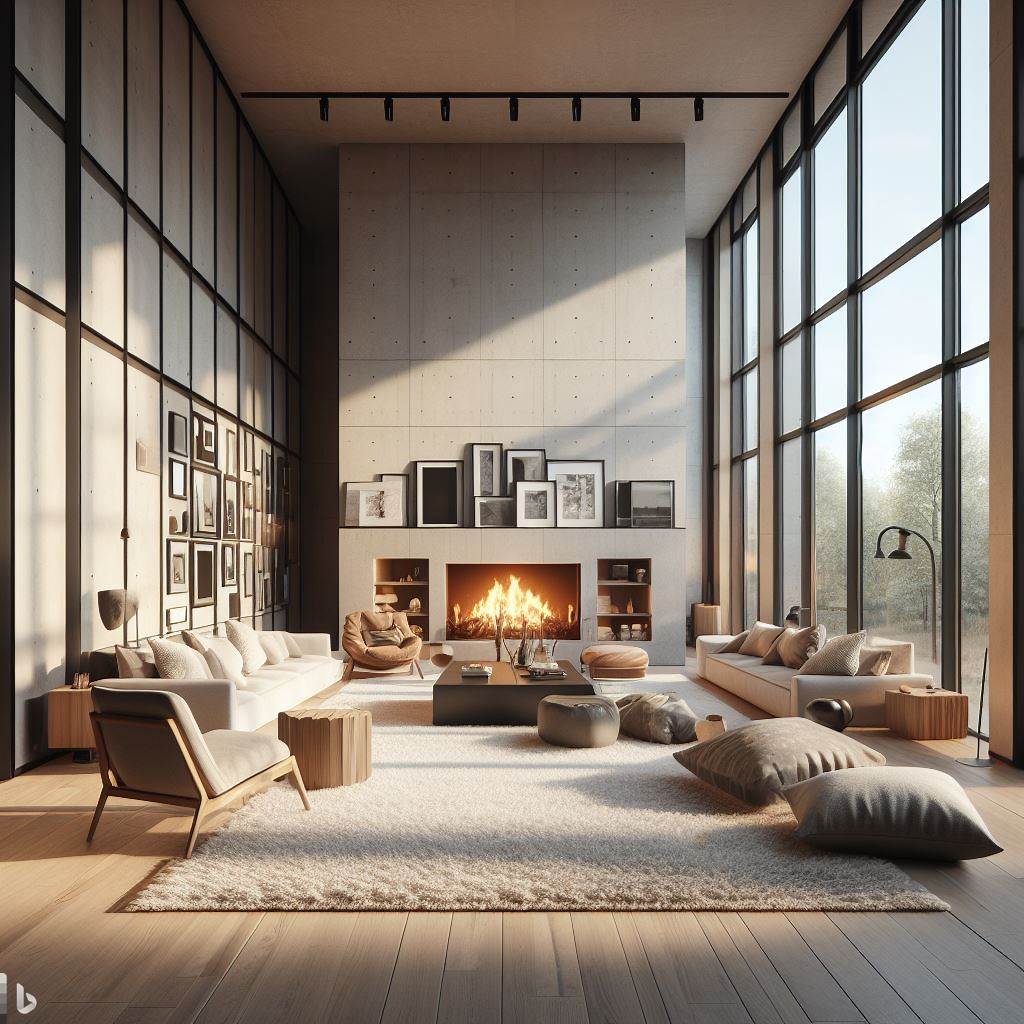
Large open spaces, while offering a sense of spaciousness and endless design possibilities, often pose a unique challenge: how to make them feel warm, intimate, and cozy. Without thoughtful design, these spaces can feel overwhelming and impersonal. However, with the right strategies and techniques, you can transform even the most cavernous room into a cozy haven. Here’s an in-depth guide to help you achieve just that.
One of the most effective ways to conquer the vastness of a large space is by dividing it into smaller, purpose-driven zones. This technique, known as space planning, helps to make a large room feel more manageable and intimate.
Consider the multiple functions that the space needs to serve. Perhaps you need an area for lounging and watching TV, another for dining, a quiet spot for reading or working, and a space for the kids to play. Arrange your furniture to create these zones, paying attention to the natural flow of movement around the room.
Area rugs are an excellent tool for defining zones. They ground furniture groupings and create visual boundaries. For instance, a large rug can anchor a living room area within a larger open plan space, making it feel like a room within a room.
Other elements like bookcases, screens, large plants, or even lighting can serve as dividers that subtly separate one area from another. These elements add architectural interest to your space and prevent it from feeling like one large, undefined area.
Scale and proportion are key in large spaces. Small furniture pieces can appear lost and out of place in a large room, making the space feel even larger and less cozy.
Choose pieces that are proportionate to the size of the room. Opt for a grand sectional sofa, a robust dining table, or a king-sized bed. These items hold their own in the space and help to make it feel more balanced.
However, keep in mind that this principle extends beyond the size of individual pieces. A large room doesn’t necessarily require more furniture; it requires larger furniture. Too many pieces, regardless of their size, can lead to clutter, making the room feel chaotic and uninviting rather than cozy.
Color is not just a part of the visual aesthetics that we perceive; it’s a powerful design tool that can seamlessly alter the mood and energy of a room. In the scenario of a large, expansive space, color can be harnessed to create a sense of warmth, intimacy, and coziness, effectively counteracting the cold and impersonal vibe that such spaces often exude. This chapter delves deeper into the profound impact of color on interior design and provides a comprehensive guide on using color effectively in large spaces.
Warm colors, such as reds, oranges, and yellows, are associated with warmth, comfort, and energy — attributes of a cozy and welcoming environment. These colors stimulate the senses and evoke feelings of happiness, optimism, and excitement. They are known to bring the walls of a room visually closer, creating an illusion of a smaller, more intimate space.
Moreover, warm colors are particularly effective in rooms with vast, open windows or high ceilings, as they counteract the coldness of the large glass surfaces and the impersonal feel of the high vertical space.
Red: Red, the most intense warm color, symbolizes passion and energy. It can be used to add vibrancy to a room. However, because of its intensity, it’s often best used in moderation or as an accent color.
Orange: Orange, being less intense than red but still warm, is an excellent choice for spaces where you want to encourage interaction and activity, like a living room or family room.
Yellow: Yellow, the color of sunshine, is associated with happiness and inspiration. It’s perfect for adding a cheerful aura to your large space.
On the other end of the spectrum, we have cool colors like blues and greens. These colors evoke a sense of calm, relaxation, and serenity, making them ideal for creating a tranquil atmosphere. They can make a room feel more expansive and airy, which, in the case of a large room, could intensify the feeling of vastness.
However, you can balance this by pairing cool colors with warm-toned accessories, textures, and lighting. This juxtaposition brings a balanced, harmonious feel to the room, maintaining a cozy vibe despite the expansive nature of the space.
Blue: Blue, the color of the sky and sea, evokes feelings of tranquility, peace, and relaxation. Lighter shades can bring a sense of calmness, while darker shades can create a sense of depth and richness.
Green: Green, the color of nature, evokes a feeling of renewal and harmony. It’s a restful color for the eyes and can be used to bring a touch of the outdoors into your interior space, creating a calming and relaxing environment.
Often overlooked in design, the ceiling, or the “fifth wall,” plays a significant role in creating a cohesive and balanced design. When painted a color slightly darker than the walls, it can make it appear lower, reducing the perceived scale of the room and making it feel more intimate and cozy. This trick is especially useful in rooms with high ceilings.
Alternatively, a lighter ceiling color can create a sense of height and openness. This is particularly useful if you want to maintain a sense of spaciousness but still create a cozy atmosphere.
Neutral colors like white, beige, gray, and brown are often used as the foundation of a color scheme. They provide a calming backdrop that allows other colors to shine. In large rooms, neutrals can help to soften the overall feel of the space, making it feel more welcoming.
Neutrals can also be used to balance out more intense colors. For instance, if you’ve opted to use a warm color like red as an accent, a neutral color on the other walls can prevent the color from becoming overwhelming.
In large, open-plan spaces, different colors can be used to visually demarcate different zones or areas within the room. This technique can help to break up the space and create a sense of order and organization, making the room feel more manageable and less overwhelming.
For instance, you might use a warm, inviting color in the living area to create a cozy, intimate feel, and a calm, cool color in the workspace to promote focus and concentration.
Coziness is not just about visual elements; it’s also about engaging the senses. Incorporating a variety of textures adds a tactile dimension to the room, making it feel more inviting.
Think plush rugs, soft throw blankets, velvet cushions, and woven baskets. Combining smooth, rough, shiny, and matte textures can add depth and interest to your space.
Patterns can also contribute to a cozy feel. They add visual weight and can draw the eye, making a large room feel more contained. Consider a patterned wallpaper or a rug with a bold design to break up a large expanse of wall or floor.
Lighting is a powerful tool in creating a warm, cozy ambiance. A single overhead light can leave shadows and make a room feel cold and uninviting. Instead, create a layered lighting scheme.
Combining ambient lighting (general or overhead), task lighting (for specific tasks like reading or cooking), and accent lighting (to highlight architectural features or decor) can help to break up the space and create pockets of warmth.
Dimmer switches are another great tool. Being able to control the light level can help set the mood and make the space feel more intimate.
Cozy is a feeling, and nothing evokes feelings of warmth and comfort more than personal items that hold meaning. Family photos, favorite books, travel souvenirs, or artwork that speaks to you can all add a layer of personalization that makes a house feel like a home.
Consider your hobbies and passions and find a way to incorporate them into your space. If you love music, create a cozy listening nook with a comfortable chair and a stylish record player. If you’re an avid reader, design a quiet reading corner with a plush chair, good lighting, and a bookshelf filled with your favorite novels.
Adding layers to your space is an effective strategy for creating a cozy environment. This could mean layering rugs on your floor, using multiple throw pillows on your couch, or displaying an array of artwork on your wall.
The key to layering effectively is to ensure that each layer adds a new dimension or texture to the space. For example, a jute rug could serve as a base on your floor, topped with a softer, smaller rug that adds comfort and color. On a couch, larger pillows could serve as a backdrop for smaller, textured ones that invite touch.
In terms of wall decor, you might start with a base layer of color or wallpaper, add a gallery wall of framed art or photos, and then include a few hanging plants or decorative elements as final touches. Each layer draws the eye and adds warmth and interest to the space.
Nature has a natural coziness that can be used to your advantage in a large space. Incorporating elements like indoor plants, natural fibers, and elements like wood or stone can bring a sense of outdoor comfort to your indoor space.
Larger plants can serve a dual purpose by acting as natural dividers in your space, helping to define those zones we discussed earlier. Smaller plants can add life and color to a bookshelf or coffee table.
Natural fibers, like wicker, jute, or wool, bring a tactile coziness to a room. Consider a woven throw blanket, a jute rug, or wicker furniture. These elements can add a sense of comfort and warmth to your space.
Wood and stone can also add a natural, grounding element to a large room. This could be in the form of a stone fireplace, a wood coffee table, or even wood beams on a ceiling.
Transforming a large, impersonal space into a cozy haven doesn’t have to be daunting. By creating defined zones, focusing on proportions, harnessing the power of color, layering with textures and patterns, using lighting effectively, adding personal touches, layering your space, and incorporating natural elements, you can create a space that feels warm, intimate, and inviting — regardless of its size.
Remember, creating a cozy space isn’t just about following design principles; it’s about creating a place where you feel at home. So, embrace your large space, infuse it with your personality, and create a space that you love to live in.

Dale is the colorful mind behind HuetifulHomes.com, where he shows you how to create a home that is as fun and fabulous as you are. He has a passion for color and a knack for DIY, with years of interior design experience he shares his tips and tricks on how to create a home that reflects your personality and style. He believes that color is the key to happiness, and he wants to help you make your home more Huetiful.